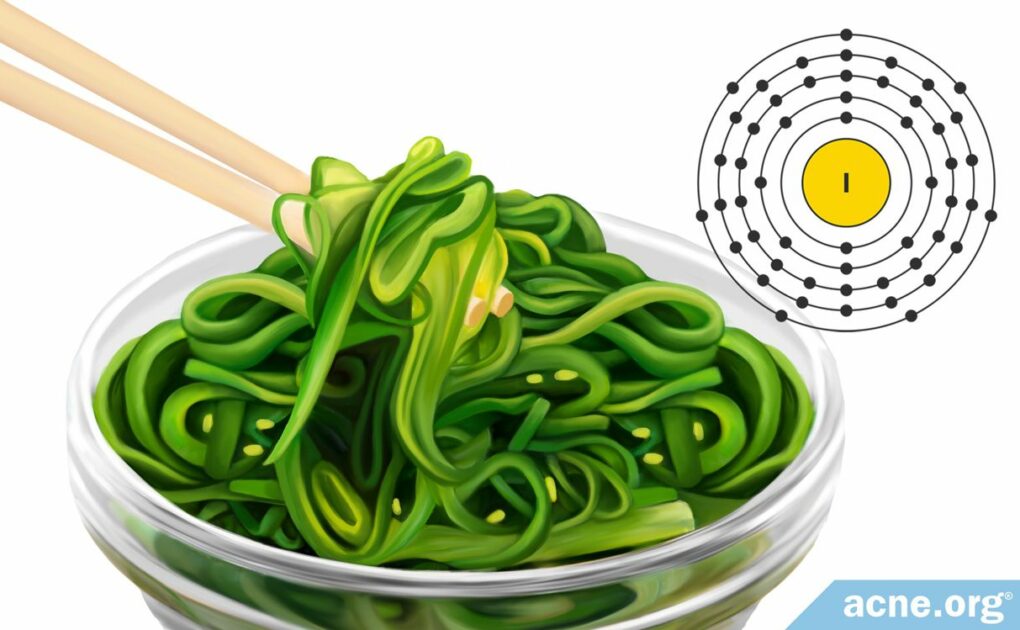Despite What You May Have Heard, There Appears to Be No Inherent Link Between the Two

The Essential Info
There is no evidence that normal intake of iodine in the diet causes acne. Any relationship between the two appears to occur only with very high levels of iodine intake, such as from kelp supplements.
Furthermore, acne-like reactions on the skin after ingesting high levels of iodine are not in fact what people know as acne, but instead a skin reaction which looks like acne that goes away as soon as the person reduces their iodine over-consumption.
The Bottom Line: You don’t need to worry about getting too much iodine unless you consume very high amounts of kelp or other seaweed, typically taken in kelp supplements, or unless you take medications that contain high levels of iodine.

The Science
- What Is Iodine, and Why Do We Need It?
- How Do We Obtain Iodine?
- The Studies: What Does the Research Say about the Relationship Between Iodine and Acne?
- The Bottom Line
The question of whether iodine intake is linked with acne has been the subject of scientific debate for decades because some studies show a relationship between high doses of iodine and acne-like eruptions called acneiform eruptions. Acneiform eruptions look like acne but are not the typical acne vulgaris lesions that many people experience during their adolescence and beyond.
As time has passed, we now have compelling evidence that there is no relationship between typical levels of iodine intake and acne. Before we look at the research concerning the relationship between iodine and acne, let’s look at what iodine is, why we need it, and how we obtain it.
What Is Iodine, and Why Do We Need It?
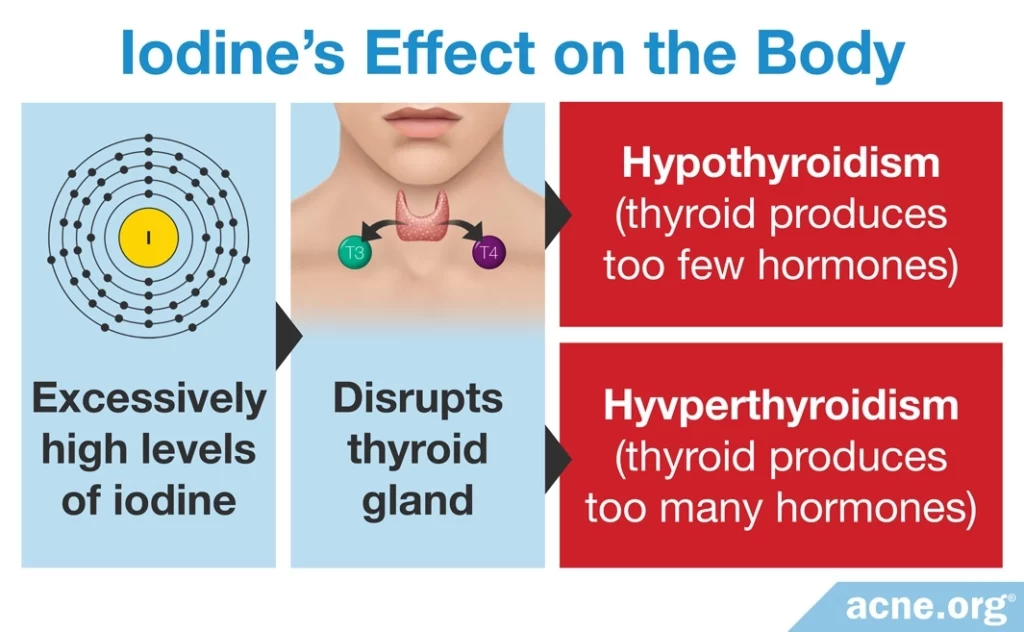
Iodine is a mineral. It is also a nutrient that is necessary for the thyroid gland to produce hormones called T3 and T4, which help keep the body functioning properly. Adequate amounts of iodine are necessary, but excessively high levels of iodine can result in either hypothyroidism (the thyroid produces too few hormones) or hyperthyroidism (the thyroid produces too many hormones).1
How Do We Obtain Iodine?
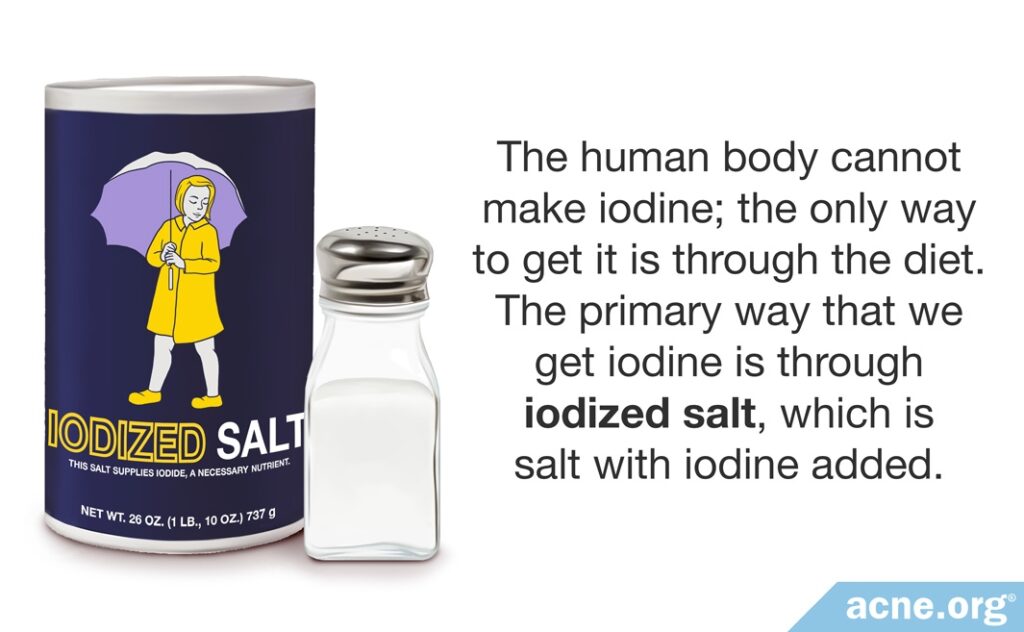
The human body cannot make iodine itself: the only way to get it is through the diet. The primary source of iodine in the modern diet is iodized salt, which is salt with iodine added. Since achieving adequate amounts of iodine in the body is important, some countries require that iodine be added to salt. The United States does not require this, but iodized salt is very common in the homes of people in the United States, and approximately 90% of U.S. households own iodized salt.
Aside from iodized salt, the most common iodine-containing foods are:
- Seaweed & seafood: Iodine occurs naturally in kelp (think seaweed salad at a sushi restaurant). It also naturally occurs at lower levels in the flesh of fish that eat kelp or other seaweeds.
- Dairy: In dairy, the iodine comes from iodine-containing cleaners that farmers use to clean the cows’ teats and the cans into which the cows are milked.
- Bread: In bread, the iodine comes from ingredients added to bread to improve its texture.
It is unlikely that eating these foods will cause an acneiform eruption.
Nonetheless, if you eat a lot of seaweed and are concerned about the iodine content, you can boil the seaweed for 5 minutes to eliminate 70% of the iodine.2
Apart from food, iodine is also present in some medications, dietary supplements, and contrast fluids used in radiology studies, sometimes in much higher amounts than is recommended. In people who are susceptible to high levels of iodine, these sources of iodine can cause problems with the thyroid gland and, in extreme cases, might hypothetically cause an acneiform eruption, which is called iododerma.1,3
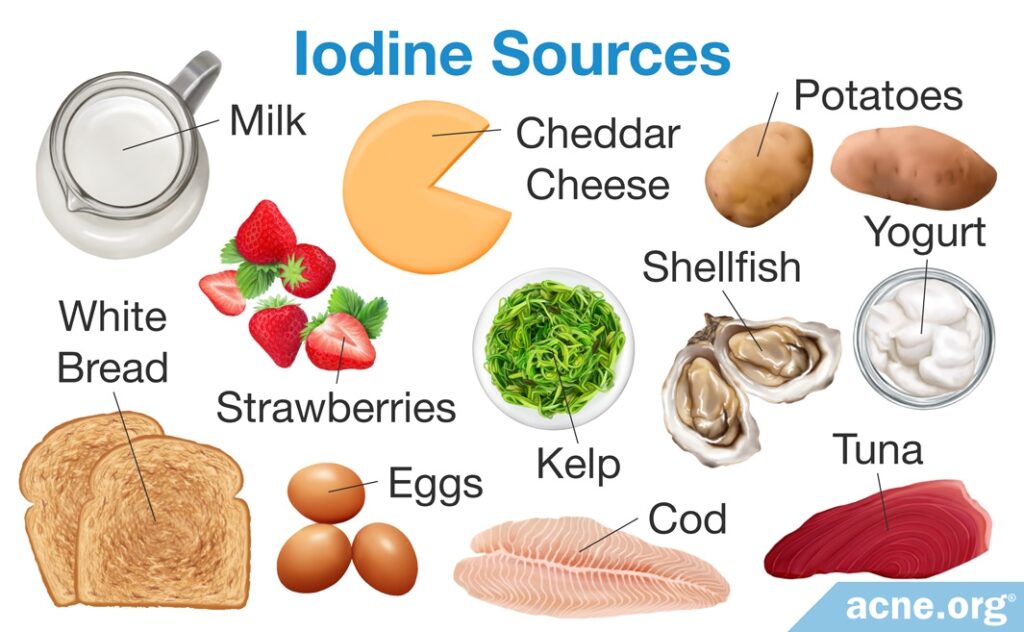
The Studies: What Does the Research Say about the Relationship Between Iodine and Acne?
For the past 60 years or so since research began on iodine and acne, studies tend to produce the same results. They show us that only very high doses of iodine cause an acne-like reaction in the skin.
Older Research
Before 1977, scientists had conducted four investigations on iodine and acne. While each group of researchers used slightly different methods, they all generally agreed that typical amounts of ingested iodine do not worsen acne.4-6 However, in two of the research investigations, people ingesting very large amounts of iodine did experience a worsening of acne.5,6
Expand to read details of research
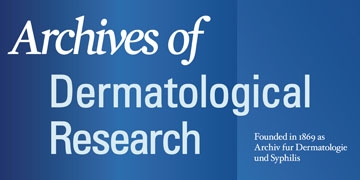
A 1961 study in Archives of Dermatology looked at whether dietary intake of iodine is related to acne. The authors distributed questionnaires to adolescents in three different regions of North Carolina and compared their dietary habits with the prevalence of acne. The authors concluded: “The results of this study in general indicate that ‘reasonable’ amounts of ingested iodine are not significant in regard to prevalence or severity of adolescent acne.”4

A 1976 article in Archives of Dermatology described two cases of young women who developed acne-like lesions after taking large amounts of kelp-containing supplements. In both cases, the acne-like lesions disappeared when the women discontinued them.5

A 1977 review of all studies up to that point, published in the International Journal of Dermatology, noted two other conflicting studies.
1. In one study, researchers started with two groups of people. One had acne, and one did not. They gave both groups a very high dose of iodine (several thousand times the normal intake) and compared the two groups. The acne patients experienced worsening of their acne, and the patients without acne developed acne-like lesions.
2. In a second study, researchers gave acne patients a moderate amount of iodine. This study found that iodine did not make acne worse, and in fact some patients experienced improvement of their acne.
The review authors concluded that normal amounts of iodine probably do not cause acne, but that it is wise to discourage patients from overdosing on it.6
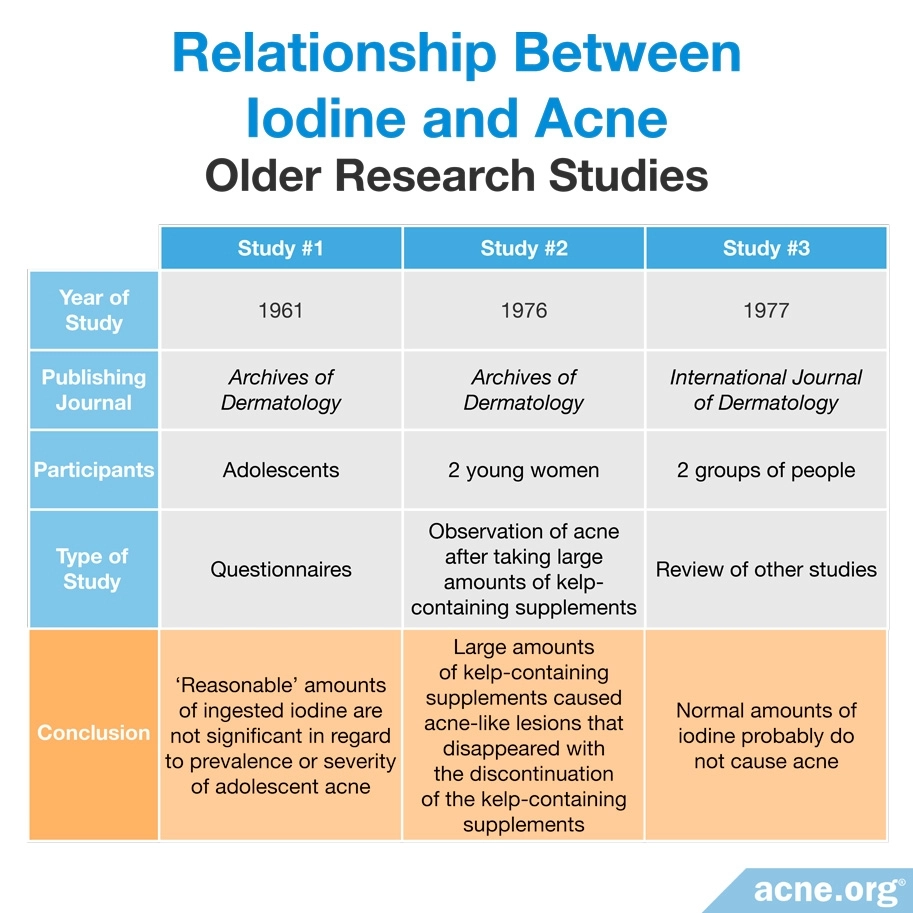
More Recent Research
Research conducted since 2005 has failed to produce compelling evidence that iodine in the diet causes acne. However, scientists continue to acknowledge that consumption of very high levels of iodine, such as consuming a diet rich in seaweed or taking medications containing a lot of iodine, may cause acne-like lesions.7-10
Expand to read details of research
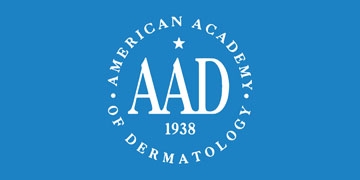
A 2005 article in the Journal of the American Academy of Dermatology, attempted to explain a hypothetical relationship between dairy products and acne: “Another hypothesis to help explain [a possible dairy and acne connection] is that the iodine content of milk may also be playing a role in the development of the acne.”7

However, a 2007 article in the Journal of the American Academy of Dermatology questioned this hypothesis. The author pointed out that milk contains only a small amount of iodine, and that in order to exceed the recommended daily amount, a person would have to drink at least 19 cups of milk per day. This author concluded: “To summarize, there is no evidence to support [iodine] as a cause of comedonal acne.”8
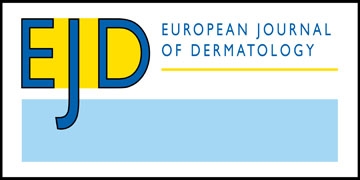
A 2010 study in the European Journal of Dermatology examined the effect of dietary iodine intake on acne in Korean patients by handing out a questionnaire and clinically assessed acne severity. This study found that acne patients consumed significantly more seaweed than patients without acne. The authors tentatively concluded that it was possible that the higher levels of iodine in seaweed might aggravate acne. The authors were purposely tentative in their conclusion, however, because there is no well-documented evidence that this is the case.9

Further, a 2010 literature review published in the Journal of the American Academy of Dermatology reviewed 19 studies that investigated the role of diet in acne. After reviewing the literature, the authors concluded that while iodine has been implicated for many years in the development of acne, there are no studies that definitively support this claim. The authors stated: “Iodine has long been implicated as a cause of acne vulgaris[;] however, no literature to date supports iodine as a culprit in comedonal acne. Acne resulting from iodine consumption typically presents as an abrupt…eruption of predominantly pustules. Kelp, a form of seaweed rich in iodine, and other systemic drugs containing iodine can cause this characteristic [acne-like] eruption.”10
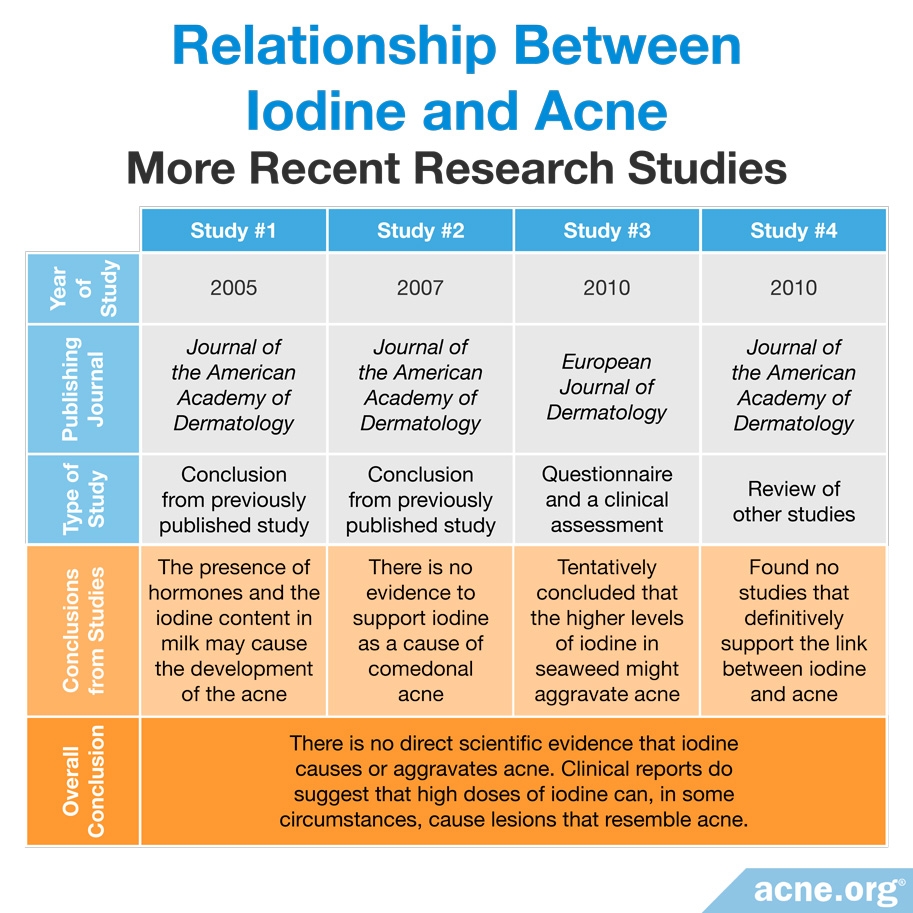
Taken together, we can conclude that there is no direct scientific evidence that iodine causes or aggravates acne. However, some reports do suggest that high doses of iodine do, in some circumstances, cause lesions that resemble acne. In these cases, the acne-like lesions disappear as soon as the patient stops ingesting the iodine.
Scientists still do not know why iodine sometimes causes these acne-like reactions, but various hypotheses have been put forward, including an immune reaction by skin cells to excess iodine, and skin inflammation.11
The Bottom Line
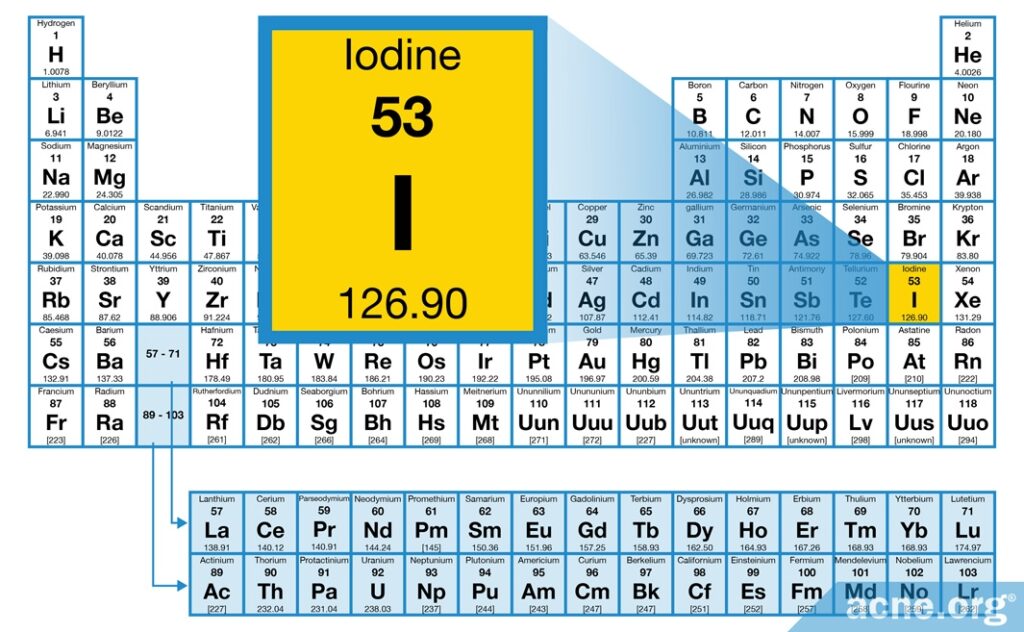
There are enough things to concern yourself about when it comes to acne, but iodine is not one of them. Don’t worry about how much iodine a certain food might contain. Instead, simply avoid taking large amounts of kelp supplements and you should be fine.
References
- Leung, A. M. & Braverman, L. E. Consequences of excess iodine. Nat. Rev. Endocrinol. 10, 136 – 142 (2014). https://www.ncbi.nlm.nih.gov/pubmed/24342882
- Salehi, B, Sharifi-Rad, J., Seca, A. M. L. et al. Current trends on seaweeds: Looking at chemical composition, phytopharmacology, and cosmetic applications. Molecules. 24, 4182 (2019). https://pubmed.ncbi.nlm.nih.gov/31752200/
- Hesseler, M. J., Clark, M. R., Zacur, J. L., Rizzo, J. M. & Hristov, A. C. An acneiform eruption secondary to iododerma. JAAD Case Rep. 4, 468-470 (2018). https://pubmed.ncbi.nlm.nih.gov/29984285/
- Hitch, J. M. & Greenburg, B. G. Adolescent acne and dietary iodine. Arch. Dermatol. 84, 898 – 911 (1961). https://www.ncbi.nlm.nih.gov/pubmed/13907780
- Harrell, B. L. & Rudolph, A. H. Kelp diet: a cause of acneiform eruption. Arch. Dermatol. 112, 560 (1976). https://www.ncbi.nlm.nih.gov/pubmed/131519
- Rasmussen, J. E. Diet and acne. Int. J. Dermatol. 16, 488 – 492 (1977). https://www.ncbi.nlm.nih.gov/pubmed/142748
- Arbesman, H. Dairy and acne- the iodine connection. J. Am. Acad. Dermatol. 53, 1102 (2005). https://www.ncbi.nlm.nih.gov/pubmed/16310091
- Danby, F. W. Acne and iodine: reply. J. Am. Acad. Dermatol. 56, 164 – 165 (2007). https://www.ncbi.nlm.nih.gov/pubmed/17190637
- Jung, J. Y. et al. The influence of dietary patterns on acne vulgaris in Koreans. Eur. J. Dermatol. 20, 768 – 772 (2010). https://www.ncbi.nlm.nih.gov/pubmed/20822969
- Bowe, W. P., Joshi, S. S. & Shalita, A. R. Diet and acne. J. Am. Acad. Dermatol. 63, 124 – 141 (2010). https://www.ncbi.nlm.nih.gov/pubmed/20338665
- Du-Thanh, A., Bensalleh, H. & Guillot, B. Drug-induced acneiform eruption. Am. J. Clin. Dermatol. 12, 233 – 245 (2011). https://www.ncbi.nlm.nih.gov/pubmed/21668032
